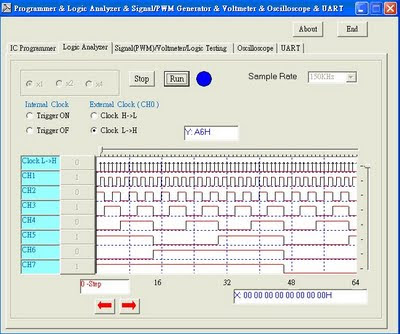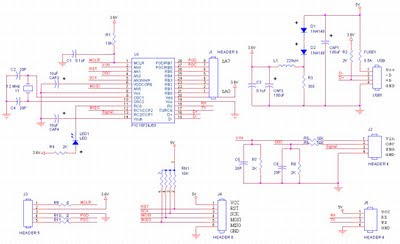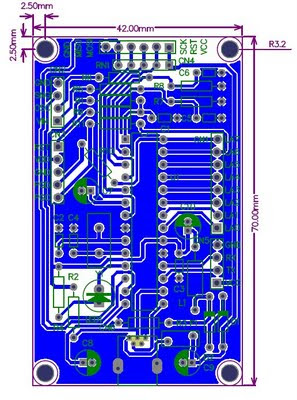USB Multi-Programmer
IC Programmer, Logic Analyzer, Oscilloscope,
UART Analysis, Voltmeter, Signal Generator,
PWM Generator, Logic Testing
IC Programmer, Logic Analyzer, Oscilloscope,
UART Analysis, Voltmeter, Signal Generator,
PWM Generator, Logic Testing
USB Multi-Programmer is a development tool of eight functional modules, programmer, logic test, voltmeter, signal generator, PWM generators, logic analyzers, oscilloscopes; and UART analysis. Besides the power it requires is supplied by USB port; therefore, no extra power is needed.
There is a polymer resettable fuse circuit on USB Multi-Programmer to protect a computer USB port. The product needs to be assembled and soldered by yourself.
Features Summary:
1. IC Programmer:
AT89S51, AT89S52.
ATmega8(L), ATmega16(L), ATmega32(L), ATmega64(L),
ATmega88, ATmega168. .... Arduino Programmer24C01, 24C02, 24C04, 24C08, 24C16, 24C32, 24C64, 24C128, 24C256, 24C512.
2. Logic Test:
Eight Channels, measure Logic-0/Logic-1.
3. Voltmeter:The voltage Range is 0V~16V.
4. Signal Generator:
The output frequency is between 1Hz and 100KHz, the square-wave signal output.
5. PWM Generator:
The output frequency is 2.9 KHz, Duty Range[1:255].
6. Logic Analyzer:
We have eight sampling channels of sampling depth 384 bits. It includes two trigger modes, “Internal Clock (Trigger ON or Trigger OFF)” and” External Clock (Clock H-> L or Clock L-> H)”. In Internal Clock Mode, the sample rate is 150 KHz, 100 KHz, 60 KHz, 50 KHz, 20 KHz, 10 KHz, 5 KHz and 3 KHz. In External Clock Mode, the maximum External Input Clock is 150 KHz.
7. Oscilloscope:
It has only one channel of depth 384 bytes. The maximum sample rate is 150 KHz, and the measure voltage range is between 0V and 16V. The horizontal axis (time) range is 0.1 mS, 0.2 mS, 0.4 mS, 1 mS, 10 mS, 50 mS, 0.5 S and 2 S, and the vertical axis (voltage) range is between 1 V and 2 V.
8. UART Analysis:
The transmission rate is 4800 bps, 9600 bps and 115200 bps, the data format is 1 Start bit, 8 Data bits and 1 Stop bit, and TX/RX Buffer is 16 bytes.
USB Multi-Programmer Pin Defination:
ISP Programmer Pin Defination:
AT89S/AVR 24CXX
1. VCC VCC
2. RST --
3. SCK SCK
4. MOSI SDA
5. MISO --
6. GND GND
SNG: Signal Generator / PWM Generator
OSC: Oscilloscope
VIN: Voltmeter
LA0~LA7: Logic Analyzer
OSC: Oscilloscope
VIN: Voltmeter
LA0~LA7: Logic Analyzer
Installation drivers:
Plug USB Multi-Programmer into USB port; if your OS is Windows, it will be detected automatically. You will see a pop-out window as the picture shown below. Click on “Install from a list or specific location”.
Plug USB Multi-Programmer into USB port; if your OS is Windows, it will be detected automatically. You will see a pop-out window as the picture shown below. Click on “Install from a list or specific location”.
Set the installation path to CD: root\inf
A security alert would come out; just click on “Continue Anyway”
The window will appear after the hardware installed done.
In Device Manager, you will see it. Please refer to following figure.
Installation USB Multi-Programmer application program:
Click on the setup.exe file in the CD.please refer to following figure.
USB Multi-Programmer application:
Plug the USB Multi-Programmer into USB Port, and open USB Multi-Programmer application.
If the connection is successful, you will see a pop-out window as the picture shown below.
End: End USB Multi-Programmer applications.
About: Definitions of pins of USB Multi-Programmer. Please refer to following figure.
Descriptions of eight functional modules of the USB Multi-Programmer
A. Programmer:
Select programming IC types (AT89S, AVR and 24C) and the programming device models, and you can click on the following functional buttons as the picture shown below, such as File, Write, Lock bits, Run, Buffer, Clear, and the speed of programming speed can be set based on the implementation of microprocessor speed. Clear is used to empty Programming Message windows.
In this multi-programmer application, it includes three programming IC types, AT89S, AVR and 24C. In addition, there are 7 functional buttons in this application; their functions are described below:
File: open program file or open EEPROM file.
Write: programming Program Memory or EEPROM Memory.
Lock bits: programming lock bits.
Run: run microprocessor.
Buffer: display Program Memory or EEPROM Memory content.
Programming Speed: set the speed of programming.
Clear: empty programming message window.
For AVR series, you can either program “Program Memory” or “EEPRON Memory”, and it also includes two File buttons, one for “Open Program File” and another for “Open EEPROM File”
Auto: It records the last status, and helps you to initialize your program quick. It includes followings steps: Please refer to following figure.
1. First, it accesses the last Program Memory File, programs Programming Memory and checks the programming status.
2.Second, it accesses the last EEPRON File, programs EEPROM Memory and checks the programming status.
3.Third, it programs Lock bits, and check the lock bits status.
4.Last, run microprocessor.
USB Multi-Programmer messages:
USB Multi-Programmer Lock bits window:
AT89S51 Lock bits window
ATmega Lock bits Window.
USB Multi-Programmer buffer:
B. Signal Generator, PWM Generator, Voltmeter, Logic Testing: Signal / PWM generator can completely setup by using mouse. The signal generator output frequency is between 1 Hz and 100 KHz, and the PWM output frequency is 2.9 KHz, Duty Range [1:255]. The voltmeter range is 0V ~ 16V.
C. Logic Analyzer:
We have eight sampling channels of sampling depth 384 bits. It includes two trigger modes, “Internal Clock (Trigger ON or Trigger OFF)” and” External Clock (Clock H-> L or Clock L-> H)”. In Internal Clock Mode, the sample rate is 150 KHz, 100 KHz, 60 KHz, 50 KHz, 20 KHz, 10 KHz, 5 KHz and 3 KHz. In External Clock Mode, the maximum External Input Clock is 150 KHz.
Internal Clock:Trigger ON: Set the CH7 ~ CH0 trigger status as 10101010.
Trigger OFF: The CH7~CH0 trigger condition is invalid.
External Clock:Clock H-> L or Clock L-> H: The External Clock input CH0 pin.
D. Oscilloscope:
It has only one channel of depth 384 bytes. The maximum sample rate is 150 KHz,
and the measure voltage range is between 0V and 16V. The horizontal axis (time) range is 0.1 mS, 0.2 mS, 0.4 mS, 1 mS, 10 mS, 50 mS, 0.5 S and 2 S, and the vertical axis (voltage) range is between 1 V and 2 V.
It can roughly calculate the signal's frequency, maximum voltage value, minimum voltage value and the average voltage value, as shown below.
E. UART Analysis:
The transmission rate is 4800 bps, 9600 bps and 115200 bps, the data format is 1 Start bit, 8 Data bits and 1 Stop bit, and TX/RX Buffer is 16 bytes.
Just enter the TX transmitted HEX Code, and it will be converted into ASCII Code automatically. By the way, the HEX Code or ASCII Code will be shown in the RX function when it receives the data.
The transmission rate is 4800 bps, 9600 bps and 115200 bps, the data format is 1 Start bit, 8 Data bits and 1 Stop bit, and TX/RX Buffer is 16 bytes.
Just enter the TX transmitted HEX Code, and it will be converted into ASCII Code automatically. By the way, the HEX Code or ASCII Code will be shown in the RX function when it receives the data.
USB Multi-Programmer Circuit:
USB multi-programmer PCB:
USB multi-programmer outline:
Steps for installation the components of USB Multi-Programmer:
1. Assemble resistance R1, R5, R6 (the 10K ohm), R3 (the 300 ohms), R2, R4, R7,R8 (the 2K ohm) and RN1 (the 4.7K ohm, attention installs Pin 1).
2. Assemble D1 and D2. (the 1N4148 diode, attention polarity).
3. Assemble LED1 (LED, attention polarity).
5. Assemble capacity C1, C3(0.1uF), C2 and C4(20pF).
6. Assemble quartz crystal Y1(12MHz), polymer resettable fuse FUSE1(0.5A) and inductance L1(220uH).
7. Assemble the USB connector and micro-controller U1
8. Assemble CN1 (Pin Header 8 Pin), CN2 (Pin Header 4 Pin), CN4 (Pin Header 6 Pin).






































沒有留言:
不接受新意見。